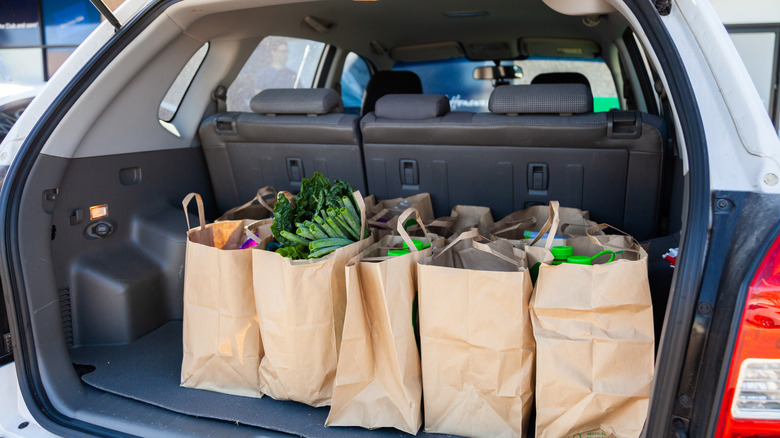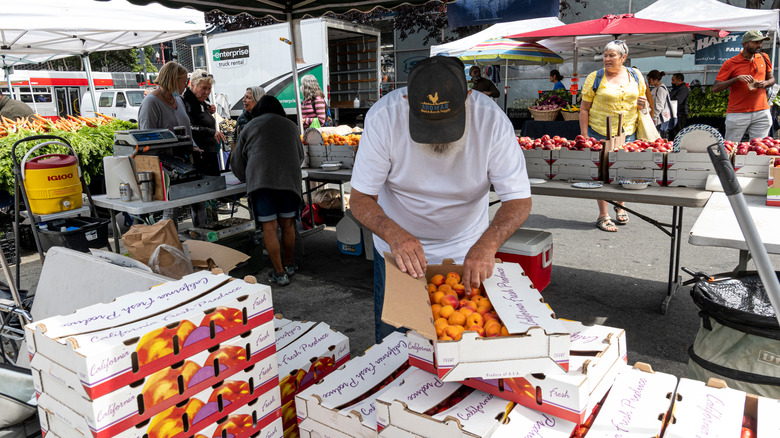Is It Dangerous To Leave Groceries In A Hot Car?
We all know that summer weather means hot cars. But did you realize just how hot the interior of your car can actually get and how quickly that happens? Particularly when it comes to transporting groceries from the store to home and the various other errands you may need to run in between. Even shortened times and slight heat elevations matter a lot, according to the U.S. Centers for Disease Control and Prevention (CDC). At room temperature, bacteria levels increase and multiply very quickly, making it so that perishable food left in the 40 to 140 degrees F range enter the "Danger Zone" for bacteria accumulation.
How that translates to groceries sitting in a vehicle is simple: Two hours is the maximum time that perishable groceries should sit unrefrigerated. If car temps climb above 90 degrees F, that window of time is cut in half to just one hour, per the CDC. A common mistake is gauging heat levels based on outdoor temperatures. But you'd be surprised how quickly and intensely a car can become a bacteria hotbed for those groceries that you've spent your hard-earned money to purchase.
How hot your groceries get inside a vehicle
A chart from the National Weather Service reveals that on a relatively mild 73 degrees F day, interior vehicle temperatures could jump to 100 degrees F in as little as 25 minutes. However, the heat actually accumulates even sooner. ABC News points out that a typical summer outdoor temperature of 85 degrees F leads to interior vehicle heat levels of 104 degrees F after just 10 minutes. They will then continue to rise, reaching 119 degrees F after just 30 minutes. These temperatures can compromise food safety very quickly.
The science of how the interior of a vehicle gets this hot and then intensifies is more complicated than just trapped air having no outlet. Shortwave energy from the sun enters through windows, heating interior objects such as dashboards, seats, child safety seats, and steering wheels, according to the National Weather Service. Those objects subsequently heat the inside air even more through conduction, convection, and longwave radiation. Meanwhile, your grocery items are heating up and potentially harboring harmful bacteria.
How to avoid the hot-car grocery syndrome
An estimated 3,000 Americans die annually from foodborne illness due to contaminated food and drinks, according to the CDC. There are some things you can do to lower the chance of it happening to your family. Consumer Reports recommends planning ahead and making the supermarket your final stop when running errands. Bring insulated bags and cooler packs, which may keep foods cold longer. Don't let the insulated bags heat up in the car. Instead, take them into the store while you're shopping. Additionally, find a shaded parking spot whenever possible.
Place frozen and refrigerated items in your cart last, especially meat and fish, warns James E. Rogers, Ph.D., the director of food safety testing and research for Consumer Reports. You should have an ice-filled cooler in the car to accommodate longer drives and reduce exposure times. When feasible, pack your own groceries at checkout, placing cold foods together so that they'll keep one another cool, per Simplemost. Vehicle trunks retain the most heat, so transport groceries in the car's interior, preferably near air conditioning vents. Finally, remember that excessive heat can affect non-perishable foods. The California Department of Education recommends keeping dry foods stored at 50 to 70 degrees F.
When all is said and done, it's relatively easy to remain vigilant about food safety. These few simple steps can reduce the danger of contaminated food and put you in control of your own health and well-being.


